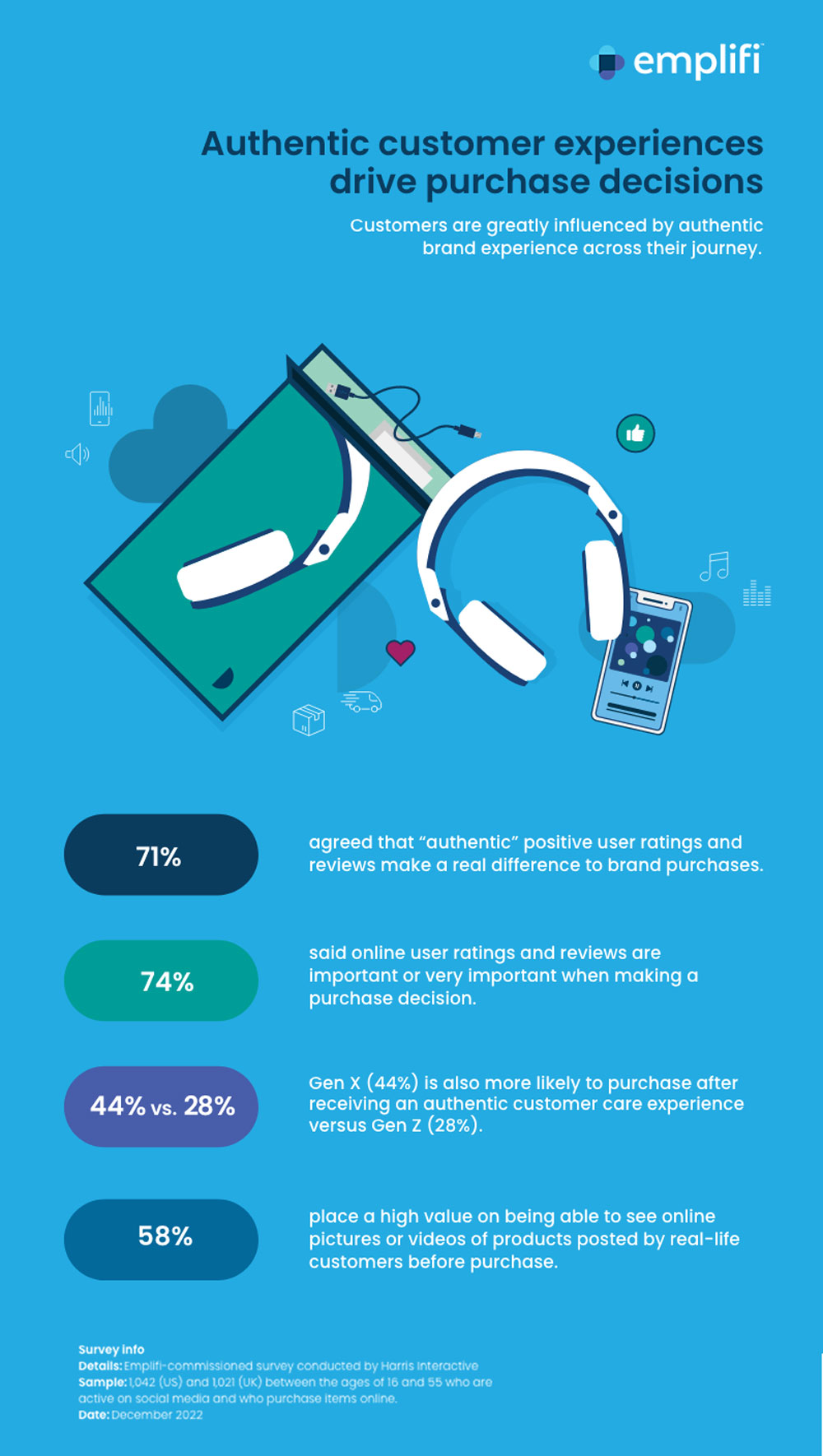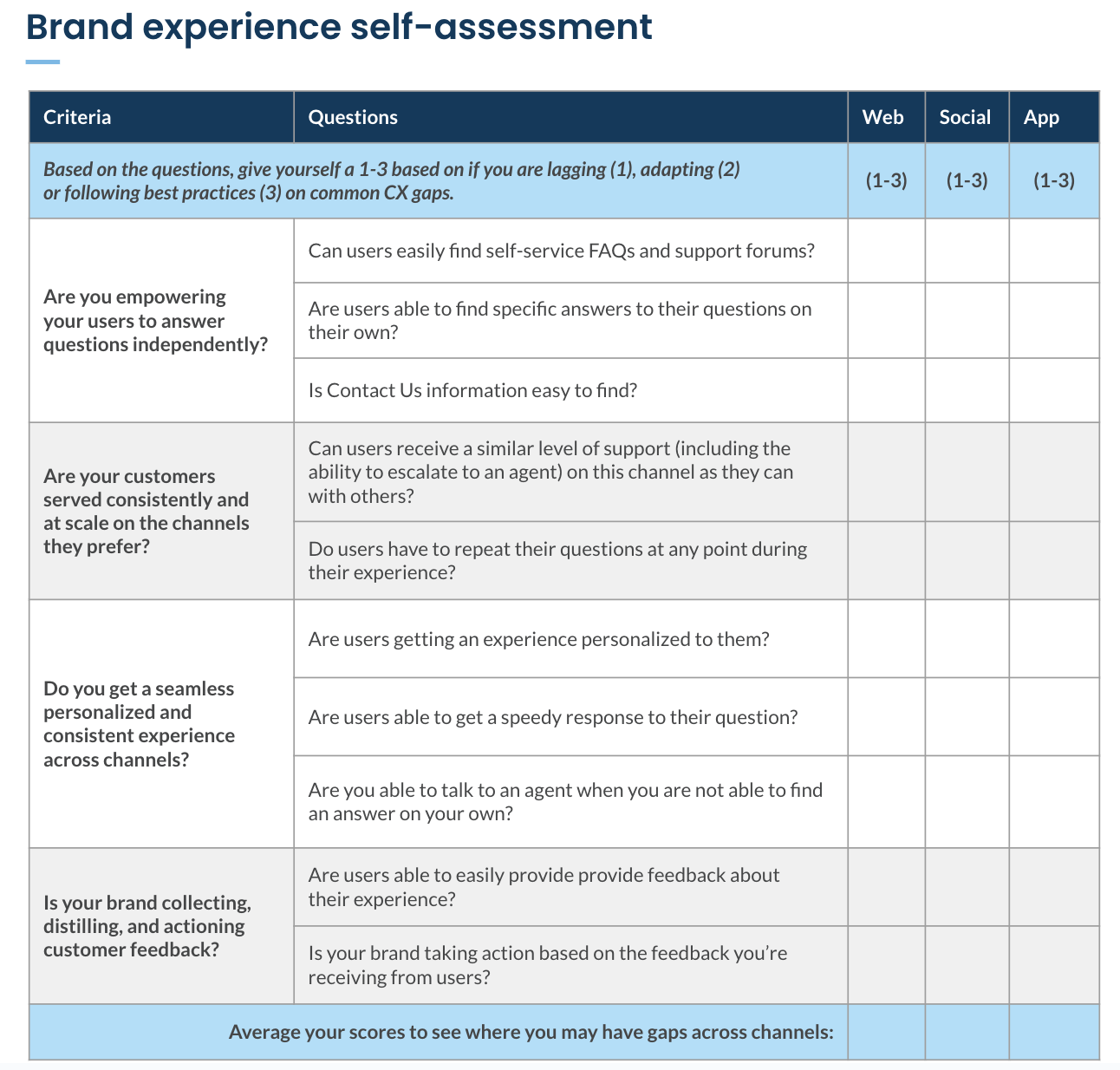Customer experience (CX) is a crucial factor that determines the success of a brand. In today’s competitive market, brands that prioritize CX are more likely to retain customers, increase revenue, and stay ahead of competitors.
Let’s examine the significance of CX and explore various strategies that brands can implement to enhance customer experiences. We will discuss how social media, artificial intelligence (AI), sentiment analysis, and personalization can be leveraged to create positive and memorable interactions with customers. Additionally, we will provide insights into measuring CX and evaluating its impact on business performance.
What does CX stand for?
CX stands for “Customer Experience.” As modern consumers increasingly turn online to navigate their customer journey, CX can refer to customers’ overall perceptions and satisfaction with any and all interactions they have with a brand on their digital or social media channels, for example.
What is CX?
CX encompasses every interaction a customer has with a brand’s social media and digital presence, including posting content, engaging with customers, handling inquiries, and helping people buy things. As social media has become a central hub for brand-consumer interactions, optimizing CX on social platforms has become essential for brands seeking to build strong, loyal customer relationships and drive revenue growth.
However, CX isn’t confined to digital touchpoints alone. It also encompasses offline interactions, from in-store experiences to customers’ interactions with store representatives to phone calls and text exchanges with customer service reps.
All told, CX represents the sum total of all experiences a customer has with a brand — digital and physical — throughout their entire relationship. It intersects with various aspects of marketing, commerce, and care, requiring brands to:
- Craft compelling messaging and storytelling content so that it resonates with customers
- Optimize eCommerce platforms for seamless transactions
- Provide a consistent, seamless experience throughout the customer journey
By prioritizing and optimizing every touchpoint they have with their customers, brands can create memorable experiences that foster loyalty, drive revenue growth, and differentiate themselves from the competition.

What is the difference between customer service and customer experience?
While customer service and customer experience (CX) are related concepts, they differ in scope and focus.
Customer service typically refers to the support and assistance given to customers when they have inquiries, issues, or need help with a product or service. It’s reactive in nature, addressing individual customer needs as they arise.
On the other hand, CX encompasses the entire journey and perception a customer has with a brand, including every interaction and touchpoint across various channels (including on social media), not just when they seek assistance.
CX is proactive and holistic, aiming to create positive emotions and experiences at every stage of the customer journey, from awareness to post-purchase interactions. While customer service is a component of CX, CX extends beyond customer service to include factors like brand messaging, usability, product quality, and overall satisfaction with the brand’s offerings. Broadly speaking, customer service is a part of the overall customer experience, which encompasses all interactions and impressions a customer has with a brand throughout their journey.
Who owns the customer experience?
The responsibility around customer experience is shared among different teams and departments.
Marketing teams: Play a crucial role in crafting brand messaging and managing the brand’s social media presence, influencing how customers perceive and interact with the brand across digital, social, and offline channels.
Customer service teams: Responsible for providing timely and helpful assistance, directly impacting customer satisfaction and loyalty.
Product development and UX/UI teams: Ensure that products and digital experiences meet customer needs and expectations.
Sales teams: Contribute by understanding customer pain points and preferences, tailoring solutions to meet their needs.
Ultimately, the entire organization, from top leadership to frontline employees, plays a part in delivering a seamless and positive customer experience. While different teams may have specific responsibilities related to CX, fostering a culture of customer-centricity and cross-functional collaboration is essential for effectively managing the customer experience in large consumer brands.

Why is customer experience important?
CX is paramount for all brands due to its proven impact on key business metrics and long-term success. Here’s why CX is so important, and be sure to check out key customer experience statistics to see its impact on the bottom line.
- Differentiation
In today’s competitive landscape, where product features and pricing can often be replicated, CX serves as a critical differentiator. Brands that prioritize delivering exceptional experiences stand out in consumers’ minds, fostering return customers and advocacy even in crowded markets.
- Customer satisfaction and loyalty
Positive experiences breed satisfied and loyal customers. When customers have seamless interactions, receive personalized attention, and feel valued by a brand, they’re more likely to come back again and recommend the brand to others, driving revenue growth.
Key stat: On average, companies that put in the work to improve the customer experience see a 42% improvement in customer retention, a 33% improvement in customer satisfaction, and a 32% increase in cross-selling and up-selling (Keap)
- Brand reputation
CX directly influences brand reputation and perception. Brands known for delivering exceptional experiences not only attract new customers but also mitigate the impact of occasional negative experiences, as satisfied customers are more forgiving and understanding.
Key stat: 40% of consumers will recommend a brand to people they know after an authentic customer care experience (Emplifi)
- Revenue growth
Improved CX correlates with higher revenue and profitability. Satisfied customers tend to spend more money, make repeat purchases, and are less price sensitive, contributing to the bottom line. Moreover, positive experiences lead to higher customer lifetime value (CLV), maximizing the return on marketing investments.
Key stat: 61% of consumers will pay at least 5% more if they know they’ll get a good customer experience (Emplifi)
- Customer retention and churn reduction
Acquiring new customers can be costly, making retaining existing ones crucial to consistent brand growth. By focusing on customer experience and addressing pain points, brands can reduce churn rates and increase customer lifetime value. This also helps prolong customer relationships and lower acquisition costs.
Key stat: 86% of consumers would leave a brand after as few as two poor experiences (Emplifi)
At the end of the day, prioritizing good customer experience isn’t just about satisfying customers – it’s about driving business success by fostering loyalty, advocacy, and sustainable growth in a competitive marketplace.
published

How to improve customer experience
Improving your CX requires a comprehensive approach that focuses on understanding customer needs, enhancing interactions across touchpoints, and continuously iterating based on customer feedback. Here are key strategies to elevate CX.
- Customer journey mapping
Customer journey maps help you understand the various touchpoints and interactions customers have with your brand across different channels. Identify pain points, moments of delight, and opportunities for improvement throughout the entire customer journey.
- Personalization
Tailor interactions and communications to meet customers’ individual preferences and needs. Leverage data and insights to deliver personalized experiences, whether through targeted marketing campaigns, product recommendations, or customized support.
- Seamless omnichannel experience
A consistent and continuous experience across all your channels and platforms is key to ensuring positive CX with your brand. Whether it’s via social media, your website, mobile app, or in-person interactions, provide a seamless and integrated experience that reflects your brand identity and values.
- Proactive customer support
Anticipate and address customer needs before they arise by offering proactive support and assistance. Provide self-service options, FAQs, and educational resources to empower customers to find solutions independently.
- Listen and respond
Solicit feedback from your customers through surveys, reviews, and social listening. Actively listen to their problems, suggestions, and feedback, and respond promptly with empathy and solutions. Demonstrate a genuine commitment to addressing customer issues and improving their overall experience.
- Employee training and empowerment
Equip frontline employees with the customer care tools, training, and autonomy to deliver exceptional customer service. Always seek ways to empower employees to go above and beyond in order to exceed your customers’ expectations and resolve issues effectively.
- Continuous improvement
Adopt a culture of continuous improvement by regularly evaluating and optimizing CX initiatives. Use social media analytics and performance metrics to track customer satisfaction, identify trends, and measure the impact of CX efforts. Iterate and refine customer experience strategies based on insights and feedback to drive ongoing improvement.
By prioritizing these CX strategies and making them a central focus of your brand’s operations, you can create memorable experiences that foster customer loyalty, drive revenue growth, and differentiate your brand in the marketplace.

How can social media enhance the customer experience?
Social media is now at the forefront of CX, playing a key role in modern consumers’ customer journey. It provides brands with a direct channel to connect with customers, gather valuable feedback, build strong relationships, and create a sense of community.
Let’s explore how social media can transform customer interactions and drive success for your brand.
- Direct communication and quick response
Social media channels offer a direct line of communication between brands and their customers, giving them an easy way to contact brands with questions, concerns, or feedback, and overall, creating a feeling of quick response.
This direct channel enables brands to address customer inquiries promptly to resolve issues and provide support in real-time. By leveraging social media for effective customer communication, brands can build trust and demonstrate their commitment to customer satisfaction.
- Gathering customer feedback and insights
Social media activity serves as a treasure trove of customer feedback and insights.
By actively monitoring social media conversations, you can gain a deeper understanding of customer preferences, needs, and pain points. This valuable information empowers your brand to make data-driven decisions, improve their products and services, and develop targeted marketing strategies. By listening to your customers on social media, your brand can stay ahead of the curve and continuously enhance the customer experience.
- Building strong customer relationships
Social media provides a unique opportunity for your brand to build meaningful relationships with your brand’s customers.
By engaging in conversations, responding to comments, and acknowledging customer feedback, you can create a sense of connection and foster brand loyalty. Social media allows you to showcase your brand’s personality, values, and commitment to customer satisfaction, creating a positive brand image and driving customer retention.
- Efficient customer service and support
Social media – particularly through social listening – can serve as an effective platform to provide customer service and support. By addressing customer concerns and resolving issues directly on social media, your brand can demonstrate their responsiveness and commitment to customer satisfaction. This proactive approach not only resolves customer queries quickly but also showcases your brand’s dedication to providing a great customer experience.
- Creating a sense of community
Social media can foster a sense of community among customers, enhancing their engagement and loyalty. By creating social media groups, hosting contests and giveaways, and encouraging user-generated content (UGC), you can build a vibrant community where customers feel connected to your brand and to each other. This sense of belonging strengthens customer relationships and drives positive word of mouth, ultimately contributing to business growth and success.
How AI can improve the customer experience
AI is rapidly transforming the business landscape, and CX is one area where it’s making a significant impact. AI technologies provide brands with the ability to deliver exceptional customer experiences by automating repetitive tasks, analyzing customer data, and providing real-time assistance.
Here are some of the ways AI can empower brands to deliver better customer experiences:
- AI automates time-consuming and repetitive tasks
This frees up customer-facing, human agents to focus on more complex tasks that require critical thinking and emotional intelligence. For instance, AI-powered chatbots can handle routine customer inquiries, and generative AI can also help summarize customer feedback, freeing up human agents to focus on complex issues that require a personal touch.
- AI helps to provide real-time assistance and customer service
In a similar vein, AI-powered chatbots and virtual assistants can provide 24/7 support, empowering customers to answer their queries themselves, helping raise customer satisfaction, and, again, reducing the burden on human customer service teams.
- AI analyzes customer data to identify trends and patterns.
By leveraging AI-powered social media analytics tools, brands can gain valuable insights into customer preferences, behaviors, and pain points. This information enables brands to tailor their products, services, and marketing strategies to better meet the needs of their customers.
Overall, AI offers a range of powerful tools that can significantly improve customer experience. These tools can empower brands to deliver exceptional CX and gain a competitive edge in today’s customer-centric market. Another way that AI and automation can help brands more efficiently identify ways to improve CX is sentiment analysis.
How brands can use sentiment analysis to improve customer experience
Sentiment analysis is a powerful tool that can be used to improve CX. By analyzing customer feedback, brands can identify customer needs and expectations, assess customer satisfaction and loyalty, detect and resolve customer issues quickly, and improve their products and services based on customer feedback.
Here’s how this insight can be put to practical use:
- Customer feedback analysis
By applying sentiment analysis to customer feedback across various channels, you can identify not just what customers are saying, but how they feel about your brand’s products or services. This deeper understanding allows you to prioritize issues that cause significant customer dissatisfaction and address them promptly.
- Product and service improvement
Sentiment analysis can highlight aspects of products or services that are particularly liked or disliked by customers. Brands can use this information to make targeted improvements, develop new features that match customer desires, or eliminate pain points in the user experience.
- Personalized customer interactions
Understanding the sentiment of customer communications can help your brand tailor its responses to match the customer’s emotional state, making interactions more personal and effective. This can be particularly useful in customer service, where empathetic responses to negative feedback can turn a potentially negative experience into a positive one.
- Market research and trend analysis
Sentiment analysis can serve as a tool for real-time market research, providing insights into consumer attitudes toward products, brands, and advertising campaigns. This can help your brand stay ahead of market trends and adjust its strategies to align with consumer sentiment.
- Enhancing customer journey mapping
By analyzing the sentiment at various touchpoints along the customer journey, you can identify moments of delight or frustration. This insight enables your brand to smooth out the customer journey, ensuring a consistently positive experience that can lead to higher satisfaction and loyalty.
- Social media monitoring
Monitoring social media for sentiment towards your brand can alert you to emerging issues before they escalate. Positive sentiments can be amplified through marketing efforts, while negative sentiments can be addressed proactively to mitigate potential damage.
- Competitive analysis
Sentiment analysis can also be applied to assess how consumers feel about competitors’ products and services. This competitive intelligence can inform strategic decisions and help a brand position itself more favorably in the market.
- Crisis management and public relations
By tracking sentiment in real-time, brands can quickly identify and respond to PR crises or negative publicity. Fast, informed responses can help control the narrative and minimize damage to the brand’s reputation.
















